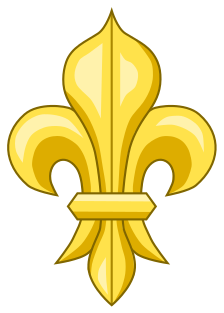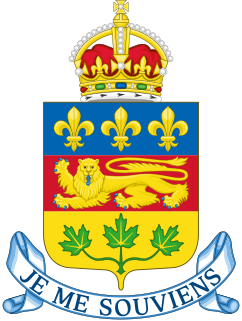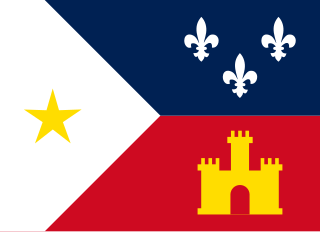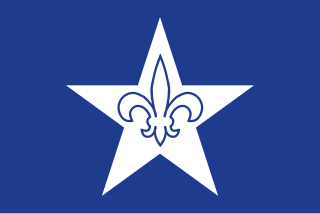
The national flag of France is a tricolour featuring three vertical bands coloured blue, white, and red. It is known to English speakers as the Tricolour, although the flag of Ireland and others are also so known. The design was adopted after the French Revolution; while not the first tricolour, it became one of the most influential flags in history. The tricolour scheme was later adopted by many other nations in Europe and elsewhere, and, according to the Encyclopædia Britannica has historically stood "in symbolic opposition to the autocratic and clericalist royal standards of the past".

The fleur-de-lis, also spelled fleur-de-lys, is a lily that is used as a decorative design or symbol.

The flag of Quebec, called the Fleurdelisé, represents the Canadian province of Quebec. It consists of a white cross on a blue background, with four white fleurs-de-lis.

The coat of arms of Quebec was adopted by order-in-council of the Government of Quebec on 9 December 1939, replacing the arms assigned by royal warrant of Queen Victoria on 26 May 1868.
Little Canada is a name for any of the various communities where French Canadians congregated upon emigrating to the United States, in particular New England, in the 19th and early 20th centuries. A variant of Canadian French known as New England French is still spoken in parts of New England.

French Americans or Franco-Americans, are citizens or nationals of the United States who identify themselves with having full or partial French or French-Canadian heritage, ethnicity and/or ancestral ties. They include French-Canadian Americans, whose experience and identity differ from the broader community.

The municipal flag of Louisville is the official design used on flags to represent Louisville, Kentucky. The original design paid homage to Louis XVI of France and the thirteen states present when the city was founded. A new design was adopted in 2003 when the city merged with Jefferson County, Kentucky.

The World Scout Emblem is the emblem of the World Organization of the Scout Movement and is worn by Scouts and Scouters around the world to indicate their membership. Each national Scout organization determines the manner in which the emblem is worn.

The flag of St. Louis, Missouri, consists of a solid red background and three thick, wavy lines colored blue and white extending from the top left corner, bottom left corner, and center right edge. At the intersection of these lines there is a yellow disk containing a blue fleur-de-lis.
The people and province of Quebec have created and established several symbols throughout Quebec's history to represent the collective identity of its residents. Many of Quebec's symbols are related to its history, to catholicism, to Quebec's winters and/or the fauna and flora of Quebec. The motif most commonly seen in Quebec's various symbols is the fleur de lys, which is associated with the French language and New France.

The flag of Baton Rouge is the city flag of Baton Rouge, capital city of Louisiana. It has a red field with a small shield and cursive text reading "Baton Rouge". The current flag was adopted in 1995 by the city council, replacing an older flag that had been in use since 1968.

The flag of the ethnic Acadian (Cajun) region was designed in 1965 by Thomas J. Arceneaux. Arceneaux was the dean of the College of Agriculture at the University of Southwestern Louisiana, now the University of Louisiana at Lafayette. He derived the flag from the University seal. Arceneaux was an early leader of the Louisiana French Renaissance Movement, a movement intended to renew interest and pride in the French-Acadian heritage, language, and culture of Louisiana.

The municipal flag of New Orleans is the representative banner of the U.S. city of New Orleans, Louisiana. The flag has a large white field that contains three gold fleurs-de-lis and is bordered on the top by a red stripe and from below by a blue stripe. The presence of the fleur-de-lis, a stylized depiction of a flower and a traditional French symbol, demonstrates the city's French heritage and strong ties to France.

New England French is a variety of French spoken in the New England region of the United States. It descends from Canadian French because it originally came from French Canadians who immigrated to New England during the Grande Hémorragie.
French-Canadian Americans are Americans of French-Canadian descent. About 2.1 million U.S. residents cited this ancestry in the 2010 U.S. Census; the majority of them speak French at home. Americans of French-Canadian descent are most heavily concentrated in New England, New York State, Louisiana and the Midwest. Their ancestors mostly arrived in the United States from Quebec between 1840 and 1930, though some families became established as early as the 17th and 18th centuries.

The Franco-Americans, or French Americans, are a group of people of French, French-Canadian, and Acadian descent living in the United States. Today there are 11.8 million Franco-Americans in the US and 1.6 million Franco-Americans who speak French at home. There are also an additional 450,000 Americans who speak a French-based creole language, for example, Haitian Creole. Even though Franco-Americans are a substantial portion of the US population, they are generally less visible than other sizable ethnic groups. This is partly because of geographical dispersal, and partly because a large proportion of Franco-Americans have acculturated or assimilated.

The flag of Fort Wayne, Indiana, was adopted as the city's official flag by City Council on June 26, 1934. The pall design includes two diagonal white stripes converging in the circular center to form a horizontal white stripe. Red silhouettes of a Miami Native American head, a French fleur-de-lis, and a British lion grace a navy blue field. A red blockhouse is located at the center of the converging stripes, with the settlement's founding date and city name.















